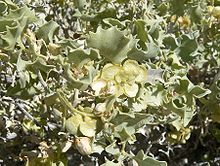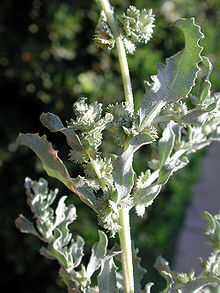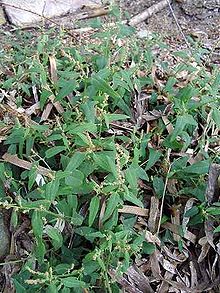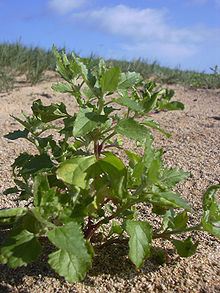- Atriplex
-
Atriplex 
Desert Holly (Atriplex hymenelytra) leaves and bracts Scientific classification Kingdom: Plantae (unranked): Angiosperms (unranked): Eudicots (unranked): Core eudicots Order: Caryophyllales Family: Amaranthaceae Subfamily: Chenopodioideae Genus: Atriplex
L.Species About 100-200, see text
Synonyms Armola (Kirschl.) Montandon
Blackiella Aellen
Cremnophyton
Halimus Wallr.
Haloxanthium Ulbr.
Morrisiella Aellen
Neopreissia Ulbr.
Obione Gaertn.
Pachypharynx Aellen
Senniella Aellen
Theleophyton (Hook.f.) Moq.[1]Atriplex (
 /ˈætrɨplɛks/[2] Á-tri-plex) is a plant genus of 100-200 species, known by the common names of saltbush and orache (or orach). The genus is quite variable and widely distributed. It includes many desert and seashore plants and halophytes, as well as plants of moist environments. The goosefoot subfamily (Chenopodioideae) of the Amaranthaceae, in which the genus Atriplex is placed in the APG II system, was formerly considered a distinct family (Chenopodiaceae).
/ˈætrɨplɛks/[2] Á-tri-plex) is a plant genus of 100-200 species, known by the common names of saltbush and orache (or orach). The genus is quite variable and widely distributed. It includes many desert and seashore plants and halophytes, as well as plants of moist environments. The goosefoot subfamily (Chenopodioideae) of the Amaranthaceae, in which the genus Atriplex is placed in the APG II system, was formerly considered a distinct family (Chenopodiaceae).The generic name originated in Latin and was applied by Pliny the Elder to the edible oraches.[3]
Saltbushes are extremely tolerant of salt content in the ground: their name derives from the fact that they retain salt in their leaves, which makes them of great use in areas affected by soil salination.
Atriplex species are used as food plants by the larvae of some Lepidoptera species; see the list of Lepidoptera which feed on Atriplex. For spiders such as Phidippus californicus and other arthropods, saltbush plants offer opportunities to hide and hunt in habitat that is otherwise often quite barren.
Contents
Use by humans
Many species are edible. However, the favored species for human consumption is Garden Orache (A. hortensis). Use of Atriplex as food is known since at least the late Epipaleolithic (Mesolithic). The Ertebølle culture presumably used Common Orache (A. patula) as a vegetable (A. patula is attested as an archaeophyte in northern Europe). In the biblical Book of Job, mallûḥa (מַלּ֣וּחַ, probably Mediterranean Saltbush, A. halimus, the major culinary saltbush in the region) is mentioned as food eaten by social outcasts (Job 30:4[4]). Grey Saltbush (A. cinerea) is used as bushfood in Australia since prehistoric times. Chamiso (A. canescens) and Shadscale (A. confertifolia) were eaten by Native Americans, and Spearscale (A. hastata) was a food in rural Eurasia.
The Garden Orache (A. hortensis), also called Red Orach, Mountain Spinach, or French Spinach, is an annual leaf vegetable with a salty, spinach-like taste.
The plant grows 1–2 m (3–6 ft) in height and the leaves are used cooked or in salads. It was commonly grown in Mediterranean regions from early times until spinach became the more favored leaf vegetable. The leaves can come in red, white and green varieties. The green leaves were once used to color pasta in Italy. Another common use of orach is to balance out the acidic flavor of sorrel.[5]
Meat from sheep which have grazed on saltbush has surprisingly high levels of vitamin E, is leaner and more hydrated than regular lamb and has consumer appeal equal to grain-fed lamb.[citation needed] The vitamin E levels could have animal health benefits while extending the shelf-life and maintaining the fresh red colour of saltbush lamb. This effect has been demonstrated for Old Man Saltbush (A. nummularia) and River Saltbush (A. amnicola). For reasons unknown, sheep seem to prefer the more fibrous, less nutritious River Saltbush.[6]
Saltbushes are also used as an ornamental plant in landscaping and can be used to prevent soil erosion in coastal areas. Old Man Saltbush has also been successfully used to rehabilitate old mining sites around Lightning Ridge (Australia).
Selected species
- Atriplex acadiensis – Maritime Saltbush
- Atriplex acanthocarpa
- Atriplex acutibractea
- Atriplex acutiloba
- Atriplex alaskensis – Alaska Orache
- Atriplex amnicola – River Saltbush, Swamp Saltbush
- Atriplex angulata
- Atriplex × aptera
- Atriplex argentea – Silvery Saltbush
- Atriplex asterocarpa
- Atriplex australasica
- Atriplex barclayana
- Atriplex billardierei
- Atriplex bonnevillensis
- Atriplex bunburyana F.Muell.
- Atriplex californica
- Atriplex calotheca
- Atriplex canescens – Chamiso, Chamiza, Four-winged Saltbush, Grey Sagebrush
- Atriplex cephalantha
- Atriplex cinerea – Grey Saltbush, truganini[7]
- Atriplex codonocarpa
- Atriplex conduplicata F.Muell.
- Atriplex confertifolia – Shadscale (Saltbush)
- Atriplex cordifolia
- Atriplex cordulata
- Atriplex cornigera
- Atriplex coronata
- Atriplex corrugata
- Atriplex coulteri
- Atriplex crassipes
- Atriplex cristata
- Atriplex cryptocarpa
- Atriplex cuneata
- Atriplex depressa
- Atriplex dioica – Thick-leaved Orache, Saline Saltbush
- Atriplex drymarioides
- Atriplex eardleyae
- Atriplex eichleri
- Atriplex elachophylla F.Muell.
- Atriplex elegans
- Atriplex erecticaulis
- Atriplex exilifolia F.Muell.
- Atriplex falcata – Sickle Saltbush
- Atriplex fissivalvis F.Muell.
- Atriplex flabelliformis
- Atriplex franktonii – Frankton's Saltbush
- Atriplex fruticulosa
- Atriplex gardneri – Gardner's Saltbush, Moundscale
- Atriplex garrettii
- Atriplex glabriuscula – Northeastern Saltbush, Babington's Orache, Smooth Orache, Scotland Orache, Glabrous Orache
- Atriplex gmelinii – Gmelin's Saltbush
- Atriplex graciliflora
- Atriplex griffithsii – Griffith's Saltbush (sometimes included in A. lentiformis or A. torreyi)
- Atriplex halimus – Mediterranean Saltbush, Sea Orache, Shrubby Orache
- Atriplex hastata – Halberd-leaved Orache, Spearscale (often included in A. patula)
- Atriplex heterosperma – Two-scaled Orache
- Atriplex holocarpa F.Muell.
- Atriplex hortensis – Garden Orache, Red Orach, Mountain Spinach, French Spinach
- Atriplex humifusa
- Atriplex humilis F.Muell.
- Atriplex hymenelytra – Desert Holly
- Atriplex hymenotheca
- Atriplex hypoleuca
- Atriplex incrassata F.Muell.
- Atriplex infrequens
- Atriplex intermedia
- Atriplex isatidea
- Atriplex joaquiniana
- Atriplex johnsonii[verification needed]
- Atriplex johnstonii[verification needed]
- Atriplex klebergorum
- Atriplex kochiana Maiden
- Atriplex laciniata – Frosted Orache
- Atriplex lampa
- Atriplex lanfrancoi [8]
- Atriplex latifolia
- Atriplex lentiformis – Quail Bush
- Atriplex lentiformis ssp. breweri – Brewer's Saltbrush
- Atriplex leptocarpa F.Muell.
- Atriplex leucophylla
- Atriplex limbata
- Atriplex lindleyi
- Atriplex littoralis – Grass-leaved Orache, Tropical Saltbush
- Atriplex lobativalvis F.Muell.
- Atriplex longipes – Long-stalked Orache
- Atriplex macropterocarpa
- Atriplex matamorensis
- Atriplex maximowicziana – Maximowicz's Saltbush
- Atriplex micrantha
- Atriplex minuscula
- Atriplex minuticarpa
- Atriplex morrisii
- Atriplex muelleri
- Atriplex nana
- Atriplex navajoensis
- Atriplex nessorhina
- Atriplex nitens
- Atriplex nudicaulis – Baltic Saltbush
- Atriplex nummularia – Old Man Saltbush, Giant Saltbush
- Atriplex nuttallii – Nuttall's Saltbush
- Atriplex obconica
- Atriplex oblongifolia – Oblong-leaved Orache
- Atriplex obovata
- Atriplex pachypoda
- Atriplex pacifica
- Atriplex paludosa R.Br.
- Atriplex papillata
- Atriplex parishii
- Atriplex parryi
- Atriplex patula – Common Orache, Spreading Orache
- Atriplex persistens
- Atriplex phyllostegia
- Atriplex plebeja
- Atriplex polycarpa – Allscale (Saltbush), Desert Saltbush, Cattle Saltbush, Cattle Spinach
- Atriplex powellii – Powell's Saltbush
- Atriplex praecox – Early Orache
- Atriplex prostrata – Spear-leaved Orache, Thin-leaved Orache, Triangle Orache, "fat hen"
- Atriplex pseudocampanulata
- Atriplex pumilio R.Br.
- Atriplex pusilla
- Atriplex quadrivalvata
- Atriplex quinii F.Muell.
- Atriplex rhagodioides F.Muell.
- Atriplex rosea – Tumbling Orache
- Atriplex saccaria
- Atriplex semibaccata – Australian Saltbush, Berry Saltbush, Creeping Saltbush
- Atriplex semilunaris
- Atriplex serenana
- Atriplex sibirica
- Atriplex spinibractea
- Atriplex spinifera
- Atriplex spinulosa
- Atriplex spongiosa F.Muell.
- Atriplex stipitata
- Atriplex sturtii
- Atriplex suberecta, or Peregrine Saltbush
- Atriplex subspicata
- Atriplex subtilis
- Atriplex tatarica
- Atriplex tenuissima
- Atriplex texana
- Atriplex torreyi
- Atriplex tridentata
- Atriplex truncata – Wedge-leaved Saltbush
- Atriplex tularensis
- Atriplex turbinata
- Atriplex vallicola
- Atriplex velutinella F.Muell.
- Atriplex vesicaria – Bladder Saltbush
- Atriplex vestita
- Atriplex wardii
- Atriplex watsonii
- Atriplex welshii
- Atriplex wolfii
- Atriplex wrightii
Formerly placed here
- Chenopodium album L. (as A. alba or A. viridis)
- Chenopodium oahuense (Meyen) Aellen (as A. oahuensis Meyen)[9]
- Halimione pedunculata (as A. pedunculata)
- Halimione portulacoides (L.) Aellen (as A. portulacoides L.)
- Manochlamys albicans (Aiton) Aellen (as A. albicans Aiton)[9]
Footnotes
- ^ "Genus: Atriplex L.". Germplasm Resources Information Network. United States Department of Agriculture. 2007-10-05. http://www.ars-grin.gov/cgi-bin/npgs/html/genus.pl?1146. Retrieved 2010-10-30.
- ^ Sunset Western Garden Book, 1995:606–607
- ^ Quattrocchi, Umberto (2000). CRC World Dictionary of Plant Names. I: A-C. CRC Press. p. 232. ISBN 9780849326752. http://books.google.com/books?id=esMPU5DHEGgC&.
- ^ Mistranslated as "mallows" in the King James Bible and as Nesseln (nettles) in the Luther Bible
- ^ Davidson (1999)
- ^ Norman et al. (2004), Pearce & Jacob (2004)
- ^ Tasmanian name, also transcribed trucanini, trucaninny, trugannini, trugernanna, etc. The plant was the namesake for Truganini, among the last of her people.
- ^ Gudrun Kadereit, Evgeny V. Mavrodiev, Elizabeth H. Zacharias & Alexander P. Sukhorukov: Molecular phylogeny of Atripliceae (Chenopodioideae, Chenopodiaceae): Implications for systematics, biogeography, flower and fruit evolution, and the origin of C4 Photosynthesis. - American Journal of Botany 97(10): 1664-1687, 2010.
- ^ a b "GRIN Species Records of Atriplex". Germplasm Resources Information Network. United States Department of Agriculture. http://www.ars-grin.gov/cgi-bin/npgs/html/splist.pl?1146. Retrieved 2010-10-30.
External links and references
- Davidson, Alan (1999): Orach. In: Oxford Companion to Food: 556. ISBN 0-19-211579-0
- Everitt, J.H.; Lonard, R.L., Little, C.R. (2007). Weeds in South Texas and Northern Mexico. Lubbock: Texas Tech University Press. ISBN 0-89672-614-2
- Pearce, Kelly & Jacob, Robin (2004): Saltbush lifts sheep meat vitamin content. Farming Ahead 153(October): 63. PDF fulltext
- Norman, Hayley C.; Freind, Colby; Masters, David G.; Rintoul, Allan J.; Dynes, Robyn A. & Williams, Ian H. (2004): Variation within and between two saltbush species in plant composition and subsequent selection by sheep. Aust. J. Agr. Res. 55(9): 999–1007. doi:10.1071/AR04031 (HTML abstract)
Categories:- Atriplex
- Halophytes
- Drought-tolerant plants
- Garden plants
- Amaranthaceae
Wikimedia Foundation. 2010.







